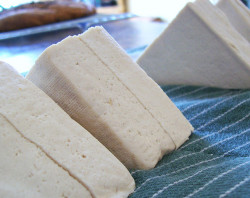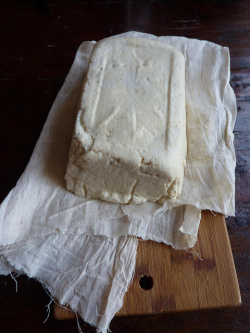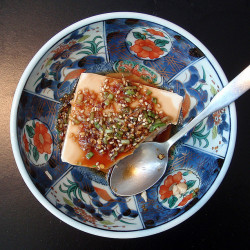Tofu: it’s the other, OTHER white protein. This wiggly, jiggly white block of beans looks unassuming, but it tends to provoke strong reactions. Either you love tofu, or you really hate it. But in my opinion, tofu’s reputation as a bland, spongey hippie food is undeserved. It’s relatively cheap, high in protein, low in fat, and is found in most grocery stores. The trick to using tofu lies in choosing the correct type and proper preparation. So, without further ado, here’s the beginner’s guide to tofu!
What it is:
When you break it all down, the process of making tofu is quite similar to making cheese. First, soaked soy beans (mature, white soybeans, not the green edamame pods you get at a sushi restaurant) are blended and strained, which separates the soy milk from the grainy bits. This is how you get the soy milk that you drink, and it’s exactly the same as making almond milk! Next, the milk is boiled, and an acid is added to make it curdle. This separates the curds (the solids) from the whey (the liquid). The soy curds are then molded and pressed into a block to squeeze out any extra whey. The longer the tofu is pressed, the firmer it will be, and also contain more calories and nutrients.
Depending on the firmness, tofu can contain anywhere from 50-120 calories per serving (think about 1/5 a regular block), plus up to 12 g of vegan protein, 40% of your daily calcium, and about a 1/3 of your daily iron. It’s also almost free of sugar.
Anyone who is wary of processed protein products should know that tofu is a completely natural product that’s been made for over 2,000 years.
Types of tofu:
Surprisingly, there are more types of tofu out there than just soft or hard. Not only is there “firm,” there’s also a range within that category from “soft firm” to “hard firm.” But first, let’s look at the major types you would likely find in an average grocery store.
– Silken or soft: As the name suggests, this tofu has a silky, slippery texture and will fall apart under it’s own water weight. Silken or extra soft tofu is unpressed, which is why it falls apart so easily. Don’t try and fight this– instead, use silken tofu raw in dishes like soups, sauces (vegan mayo!), and smoothies. Silken tofu is also a great stand-in for eggs or yogurt.
– Medium: Next up in the levels of firmness, medium tofu is the consistency of the cubes found in your average miso soup. It’s also commonly used in tofu scrambles or tofu “ricotta,” or any other dish that calls for crumbly texture.
– Firm: As previously mentioned, this tofu can range from a little firm to a hefty, compact brick. Firm tofu is the hardiest and will keep its shape no matter how you cook it. From baking to frying, firm tofu is the most versatile.
– Smoked: A little more exotic than your average tofu, smoked tofu is a dense and chewy block. It is often smoked in tea leaves, and lends a smokey flavor to your dish. Use sparingly, as it has a strong flavor than can dominate everything else.
– Sprouted: This extra-dense block is made from sprouted soybeans to breakdown anti-nutrients (which prevent the absorption of nutrients) and increase healthy live enzymes.
Now that you know the basic types of tofu, here are some helpful hints to keep in mind when preparing it.
Tofu tips:
– Tofu is a culinary chameleon. Its neutral flavor allows it to take on whatever flavors are already in the dish. Because of this, think of tofu as a texture rather than a taste.
– For better results, drain and press your firm tofu once you take it out of the package. Wet tofu will not crisp or brown up no matter what you do, and nobody likes a soggy tofu. The key to crispy pan-fried tofu: Add it to a pan that’s already hot and oiled (hear the sizzle), and let it cook for at least 4-5 minutes, until the side is completely golden brown. Non-stick pan is the best to prevent sticking and promote browning.
– You get what you pay for! If tofu is going to be the star of your meal, go for the higher quality tofus that are shrink wrapped and skip the watery plastic trays.
– Keep any leftover tofu in a container and cover with water. It will stay fresh in the fridge for 3-4 days as long as the water stays clear.
What are your tips and tricks for cooking with tofu? Share the wealth and share some recipes in the comments!
Related: Is Soy Safe? The Truth about Soy
Pan Fried Tofu and Kimchi Sandwich
Also by Sarah: 7 Ways to Practice Mindfulness in Your Daily Life
Photo credit: Sarah R. via Flickr; kattebelletje via Flickr; Joy via Flickr







